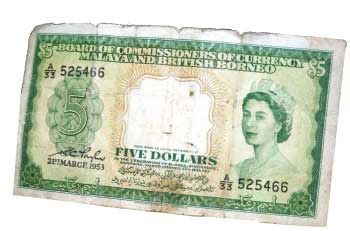This is an informative article about the history of money in Malaysia written by 14 year old Devan Tisdale, of Heidelberg, Germany which was published in the NST:

Throughout history, money has been the pulse of civilisations. The earliest form of money was not the paper bills and coins that we know today. They were possessions and objects such as cows or pottery. These were traded for anything the owner might have been in need of.
Unfortunately, unless you were a shrewd negotiator, this method wouldn’t favour you. Also, changes in the value of certain objects, too, could not work in your favour. Soon, as a result, coin-based currency began to take hold.
Among the earliest civilisations to use coins were the Greeks and the Chinese.
The Romans caught on later, and soon the practice spread around the globe, although it did not completely replace the bargaining method or barter trade.
Early coins were usually made of a mix of metals, and, later, the coins were made of gold or silver.
Forgery became a problem but this was solved when mints made coins with ridged edges which were hard to duplicate.
pix_topright
But then, changes in the weight and purity of coins caused inflation and it became harder to control.
The ancient banking systems in Europe collapsed after the fall of Rome and did not resume until the Crusades.
The Chinese became the first to develop paper money due to a severe shortage of copper (circa A.D. 815). The idea behind paper money is that each bill would be backed by its value in gold or silver by the government.
China was forced to abandon paper money around A.D. 1455 due to severe inflation but started again a while later.
Other governments had similar problems when they adopted paper money, but eventually the system settled down to become what we are familiar with today.
Malaysian Money
The history of Malaysia’s money is even more interesting. Originally, tin cubes of varying size were the currency of Malaysia. Over time they were made in many different styles.
Did you know that Malaysia once had coins shaped like animals such as crocodiles and elephants?
Another distinct style of the period is the “coin tree”. This was a metal rod with “branches” of coins. When needed, these coins could be broken off and used. The spare metal was then turned into more coins.
The first actual money to arrive in Malaysia was in the form of bronze coins brought by Chinese merchants. Eventually the Malacca Sultanate began to issue their own currency of gold, silver, and bronze coins.

This in turn was replaced, as the colonial powers came to Malaysia, with each one introducing its own currency.
Portuguese, Dutch, and English money have been the currency of Malaysia at one time or another.
However, the first paper money was once again from the Chinese banks that had opened branches in Malaysia.
During the rule of the Government of the Straits Settlements, the main forms of money were the Spanish Dollar, the Dutch Doit, and the Singapore merchant tokens.
Eventually, after the departure of the British, Malaysia began circulating what we know now as the Malaysian Ringgit (it was originally called the Malaysian dollar and represented with the sign M$). Malaysia has even issued its own gold bullion called the Kijang Emas after the barking deer.
--------------------------------------------
Having read the above article, you might be interested to watch some videos on
how money is created today and how it affects your life.
Please post your comments




 Throughout history, money has been the pulse of civilisations. The earliest form of money was not the paper bills and coins that we know today. They were possessions and objects such as cows or pottery. These were traded for anything the owner might have been in need of.
Throughout history, money has been the pulse of civilisations. The earliest form of money was not the paper bills and coins that we know today. They were possessions and objects such as cows or pottery. These were traded for anything the owner might have been in need of. This in turn was replaced, as the colonial powers came to Malaysia, with each one introducing its own currency.
This in turn was replaced, as the colonial powers came to Malaysia, with each one introducing its own currency.  According to a recent article in the Star, Malaysians are getting obese because we eat round the clock.
According to a recent article in the Star, Malaysians are getting obese because we eat round the clock.